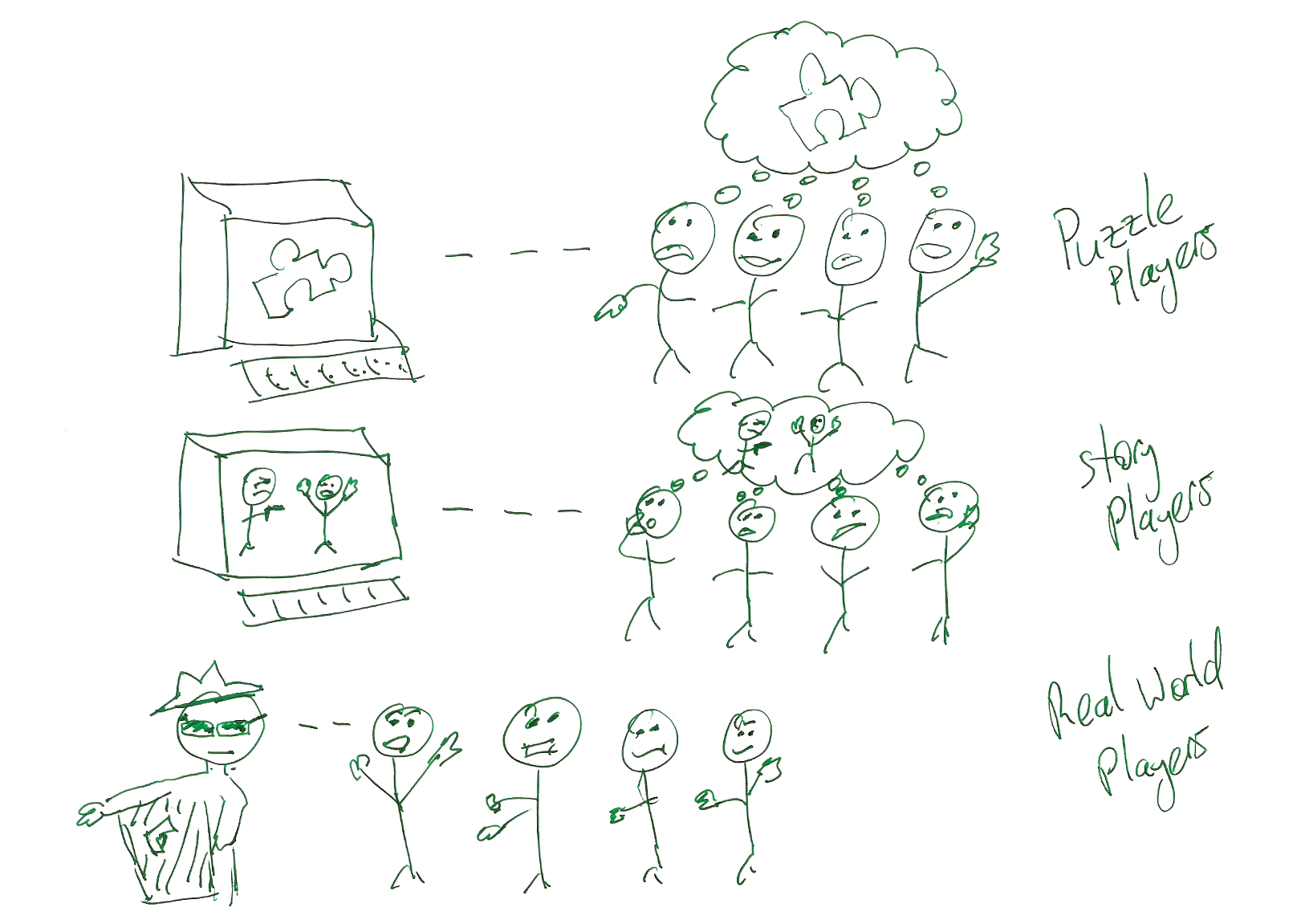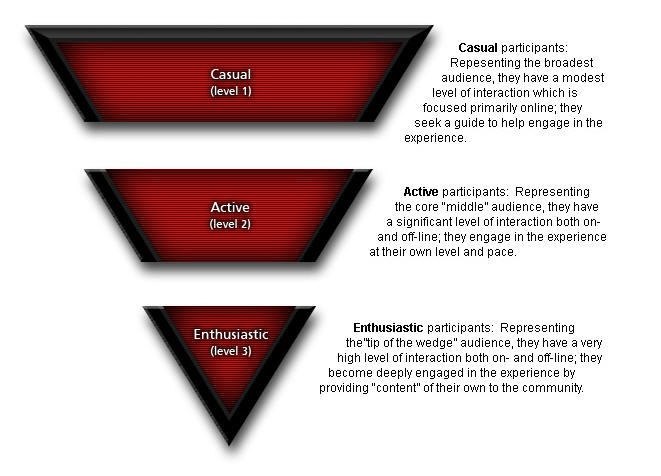1.2 Tier Types
Tiers cannot exist without a target audience in that they are usually created with certain audiences or players in mind. I cite pervasive game designer and researcher Jane McGonigal in the journal essay and so will supply a different quote here. The following is a recent comment by the Chief Creative Officer of 42 Entertainment Alex Lieu in an ARGNetcast (2007) on their design philosophy:
We recognise that there are lots of different audiences and hopefully we want to build an experience that reaches a lot of different people in a lot of different ways. [...] For some people it is just watching the story unfold, for other people it is about solving impossible puzzles and showing what they can do, for others its the community that actually fosters from it and the engagement. [...] We recognise that there are lots of other levels of engagement people have, whether they just want to hear about it, or talk about it or feel cool because they put it on their blog or whether they want to get into deep communities and solve the most ridiculous puzzles, some people want to go out to live events or track things down. We want to provide an experience that not only touches all of those different points but that all of those experiences come together to form a cohesive whole.
Tiering describes what McGonigal (in the journal essay) and Lieu outline as a multi-player and multi-audience ARG design approach. The following are examples of ARG tiering:
1.2.1 Tier Type: Artform Tiering
Artform tiering is evidenced at the World Tiering examples I gave on the previous page: where an ARG is one artform and a feature film another. But another kind of artform tiering is that which could be described as game tiering: where different games are offered that target different players. Last Call Poker (42 Entertainment, 2004) not only had a fully-functioning online poker site and community, but some of the poker players did not participate in the ARG and others continued playing after the ARG had finished (Peters, 2008). The only relationship, however, between providing content for non-ARG players and the ARG was to create an active poker community to facilitate a rich existing ARG world...and perhaps to introduce the players to the ultimate aim of the ARG: Activision's 'Gun'.
1.2.2 Tier Type: Player Gameplay Style
The PM-created (ARG designer) work-level tiering I explore in the journal essay addresses three types of ARG gameplay styles: puzzle, story and real world players. In the journal essay I give other examples of how ARG designers target these players directly, but here you can revel in my cartoon artistry:
 |
|---|
Figure 6. Visualisation of ARG Player Gameplay Style Tiering
1.2.2.1 Puzzle Players
Fundamentally, puzzle players are attracted to the different forms of cryptographic challenges: stenography, morse code, caesar, vinegere, ROT, braille, anagrams, ASCII and more. As I mentioned earlier, one of the goals of Majestic (EA, 2001) was to appeal to both casual and hard-core gamers. Writer and educator Carolyn Handler Miller (2005) notes that this didn't go too well:
The newbies complained about having to download the tools needed to play the game, and had trouble following the clues and solving the puzzles. Meanwhile, the experienced gamers grumbled that the puzzles were too easy and that Majestic was not challenging enough.
Szulborski (2005, pp.111), who was a beta-tester of Majestic , notes that EA attempted to supply difficult puzzles and content during the 'standby' mode of gameplay with content that was 'not part of the central storyline'. Designer Greg Gibson (2006) describes this 'sidequest' called 'Revelations':
For serious players, Majestic's gameplay was too easy. It could be fun if you just wanted to play a role in the story; it wasn't so good if you wanted to figure out puzzles. Except for an optional sidequest that some of us worked on late in the development cycle, the game offered few challenges for serious gamers. The puzzles were simple, and the game all but solved them for you if you took too long. A good deal of the infrequent gamers who tried Majestic actually liked its gameplay, but they had other issues with the game. Soon after the game's launch, a few of us did work on an optional sidequest, Solitaire's Puzzle, that was much tougher and deeper than the mission critical parts of Majestic. But it was added too late, and those who played it often wound up enjoying the sidequest more than the main game itself. Maybe we should have used it as an ARG to promote our ARG! In retrospect, it gave us the idea of offering different gameplay paths for different types of players.
It should be noted too that the puzzle gameplay highlighted here does not necessarily include basic interaction in ARGs. All ARGs require players to find the next location (in any media) of content. There can be other puzzles on top of cross-media traversal design. Puzzle players can sometimes take care of the cross-media traversal mechanics on behalf of the other players and/or can busy themselves with more complex puzzles that also reveal more information. But puzzle players are not the only ones who are skilled at cross-media traversal mechanics. There are game mechanics specific to ARGs that most ARG players (and not 'lurkers' therefore) know, such as what I have provisionally called:
- Nouning a URL: players extrude a noun (place, person, thing) from PM content and enter it into a URL, either adding a '.com' after the noun or before 'blogspot.com', or adding the noun to social networking sites such as MySpace and Facebook;
- No 555: Unlike 555 phone numbers which are fictious phone numbers in Hollywood designed to prevent people from calling them, players get further information by acting on any phone number, email address, real life address (sometimes), password or URL included in any ingame (diegetic) content;
- Reading the Code: players find links to websites or general game clues by reading the source-code of websites;
These are certainly not the only ARG mechanics, but the point I wanted to make was that cross-media traversal puzzles are not always the sole activity of so-called 'puzzle' players.
1.2.2.2 Story Players
Story players are provided for in poetic discourse, plot and characters. ARG designer Brooke Thompson (2006, pp.47) describes what she terms 'story specialists' as follows:
Story specialists actively attempt to figure out the overall story arc. They spend their time engrossed in the story that is presented, and speculate on where that will lead in the future. A strong consistent story that provides hints at information and relationships is key to engaging the story specialist. This provides outlets for speculation, while not being so open ended that speculation is a futile exercise. [...] Story specialists tend to be the most passionate about the experience, and often hold onto that passion long after the experience has concluded.
1.2.2.3 Real World Players
And then, for players that are keen to participate in public, there are challenges that require players to go to real world locations to complete a challenge or interact with characters. These challenges are limited to a very small set of the playing community and so it is the task of players to report on the event (which I look at in the journal essay), but also the designers work to ensure other players are included in some way. For instance, Art of the Heist (Campfire, GMD Studios, McKinney-Silver, 2005) had a real world event that required the players to retrieve a SD card from an Audi at an Audi dealership in Atlanta. The producers set up a diegetic (ingame) reason to have the event streamed live on the web so that players all around the world were able to watch as the event occurred.
 Fig 7. Still from webcam footage of card retrieval, Art of the Heist (2004) Fig 7. Still from webcam footage of card retrieval, Art of the Heist (2004) |
|---|
1.2.2.4 Community Players
These are most certainly not the only gameplay style tiers in ARGs -- indeed both Thompson and Lieu include 'community' as an attractive game experience mode. This attraction blends into my journal essay argument that mass audiences of ARGs (lurkers) enjoy the 'shadow-story' of the player-created gameplay resources. 'Shadow-story' is a term ARG player Brandie B (2008) employed to describe her attraction to ARGs:
The most appealing aspect of this new genre of game/story, to me, was the community of people, the kind of people the games attracted. People from all over our vast-yet-tiny world, with different skills, different ideologies, all dedicated to solving the mysteries and participating in the experience of each game. After reading through game guides for The Beast and ilovebees, I found that the players and the way they shaped the story by their actions and interactions with one another as well as the story-world, fascinated me as much as the story itself. The community experience created a second, shadow-story that followed alongside the same path as the game’s narrative. I’d seen this same effect in my role-playing groups, but never to this extent - hundreds, sometimes thousands of people, all deeply affected by playing the game and by their associations with each other.
1.2.3 Tier Type: Geographic Tiering (Player Location)
Another way players are targeted with separate content in ARGs is when ARG designers provide unique information to players in different geographic locations. Examples includeI Love Bees(42 Entertainment, 2004) when they had players answer payphone calls in over 50 states in eight countries (McGonigal, 2005 b), andThe Lost Experience(ABC, 2006), when they provided unique clues were distributed to players by the ABC in the US, Yahoo!7 in Australia and Channel Four in the United Kingdom. AlthoughVanishing Point(42 Entertainment, 2007) is not necessarily regarded as an ARG (see footnote [2]), it is worth noting the clues were distributed at live events in Washington, California, Canada, England, Germany, Singapore, Arizona, Texas, Florida, Australia and Nevada.
1.2.4 Tier Type: Player Expertise
ARG designers also create content specifically for different experience levels and skill sets commonly known as 'hard-core' and 'casual' players. Sometimes 'casual' players are regarded as 'lurkers' in ARGs and other times as having a reduced amount of skills (and time). In this section I'm referring specifically to player expertise. In the journal essay I discuss the player expertise tiering exercised by Xenophile Media with their ReGenesis ERG II (2006) and so here I'll outline two techniques employed by the PMs of Metacortechs, the ARG set in _The Matrix _universe. PM Steve Peters outlined one technique of creating a hierarchy of content and ensuring that which is pertinent is provided in the most accessible puzzles:
Scalability is real important because you want it to be playable by a small community or friends or whatever but also want anyone to be able to come in and look at it once and a while and play along. [...] Also as far as scalability in the design we wanted to make sure that puzzles -- because we realised with The Matrix that we would have multiple communities that would play along with this [...] -- we needed to design puzzles in a way that [ensured] critical information that was absolutely necessary to the game was not only available to a puzzle that maybe only five people solved and post about, because the dissemination of the information was a challenge because there were tons of communities.
As I argue in journal essay, the content experienced by the majority of ARG audiences (lurkers) is the player-created resources. But this becomes an issue in ARGs that are played in non-ARG communities when perhaps they don't access the player-created resources as much. Another technique employed by the _Metacortechs _PMs is explained by Thompson:
One of the things that is important when you're dealing with a large audience is making it possible for people to come in and play instantly [...] while [giving them] time to catch up on the backstory. We did this in two or three different ways. One was with the paint-over puzzles. [...] Every week there was a puzzle that had the exact same format to solve, it was just the content of which was different. So players knew exactly how to solve it, new players could look up quickly and see the formula for solving it [and] they could then go in and get some information. So they had an instant task, and while they completed that, it provided time for them to go back and read the rest of the story of what had happened.
Both of these techniques outline ways in which the first-contact with the ARG is highly accessible to players with no or little ARG expertise, whilst also providing for the more experienced players who may not have the time to learn a new game mechanic. It is such time-constraints that are also included in 'player engagement'.
1.2.5 Tier Type: Player Engagement
By player engagement I refer specifically to the amount of time and effort exerted. Player expertise and engagement are often bundled together (as per the examples above) and this chart on the different 'levels' by 42 Entertainment:
 Figure 8. 'Audiences' chart from 42 Entertainment (n.d.) Figure 8. 'Audiences' chart from 42 Entertainment (n.d.) |
|---|
Indeed, the more time a player spends with a project the more skills they will develop, which then also translates to different expectations and interaction modes, as Jones (2007b) explains:
I think what's happened is that in the work that I've done, it's become very apparent that there are different methods of interaction that go on and levels of engagement and they almost, if you were to plot them on a map, they almost cluster into different areas and you can probably imagine what they are. There are some people who they've heard of something, they thought it might be interesting, they drop in and they have 30 seconds that they are interested. Those are the very earliest people that come to a project are the ones that just sort of flip between websites and if something doesn't capture them in the first minute, then they're gone. There are other people who are browsing around and want to try something for a little while and then you start to go all the way up in the different stages of interaction and all the way up to that top tier that we were discussing earlier where people, they are insatiable at the top. There really isn't a single piece of the story world that they haven't been exposed to and want more of.
Although the two tiers are often entwined, they are separable. There are some players that are new to the genre but are willing to spend time to explore it, and there are also experienced ARG players that simply not have the time to devote to discovering the world or maintaining gameplay. In her post about the playing experience of _The Beast _and her current ARG design goals, Phillips (2006) observed that there need to be games that allow different engagement options:
It looks at first like a trade-off, of course; do you provide a shallow but pleasant experience or do you provide an all-encompassing one? My hope is to structure games where that's a false dichotomy. Games where a player can spend ten minutes a week, or every waking hour, and in either case come away with an enjoyable experience. Multiple levels of content available to suit your lifestyle.
Likewise, the designer of Majestic , Neil Young (Brown 2001), credits his own lifestyle restrictions as influencing the design of the ARG:
As you age, your ability to spend six hours a night playing a game changes. [...] I was struggling to find 30 minutes to an hour a night to invest in any type of entertainment, and wanted to create something that didn't require you to spend hours with it each night in order to feel successful at it.
_Majestic _did try and design for different playing times, but as designer Greg Gibson (2006) reflected in hindsight, it is also important to ensure all player tiers are treated equally:
[T]o fully enjoy Majestic's story, which was dense, convoluted, and a puzzle in its own right, you had to be fully invested in it. While that's not too much to ask from someone who will spend hours combing the Web for minutiae and looking for clues and patterns in that information, it's not fair to the people who are happy with their 15 minutes of content per day. It's good to reward those who would go the extra mile, but you shouldn't punish those who do no more than they're required.
While I'm not claiming that ARGs try to appeal to every single player need, it is evident that with the ability to separate content ARGs can address a greater variety of needs. ARGs are multi-track in a sense, games that not everyone has to rattle along the same through.
As I have explained basically here (and in more depth in the journal essay), World and Work Tiering in ARGs describes the phenomenon of separate content for different audiences and/or players. When ARG designers tier a work, they provide unique information to players through tier types (eg: player experience tiering, geographic tiering). What this dispersing of information to different audience segments does is facilitate players working together to share and analyse their unique discoveries. How players do that is explored in the next section on ARG GamePlay Resources.